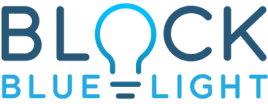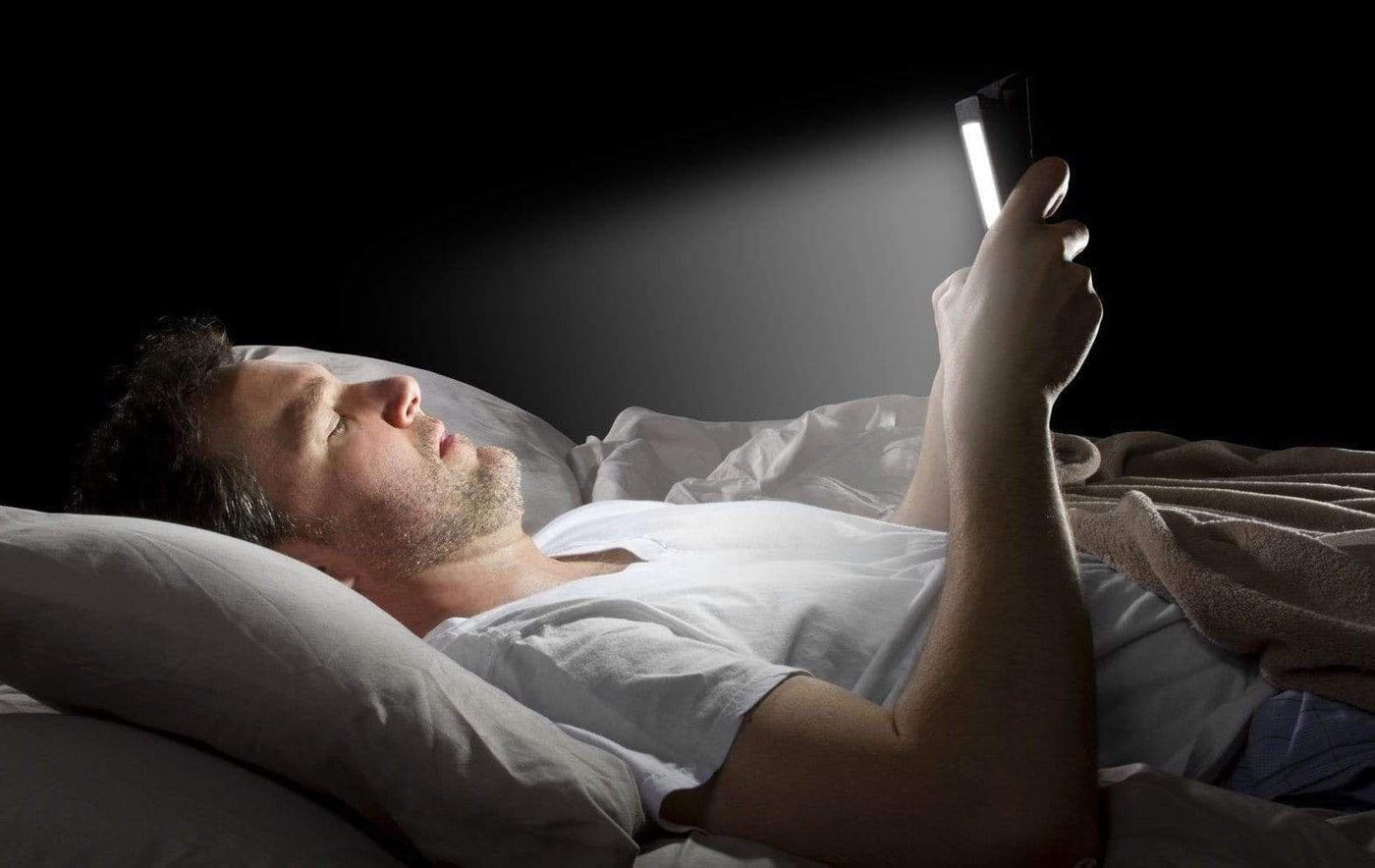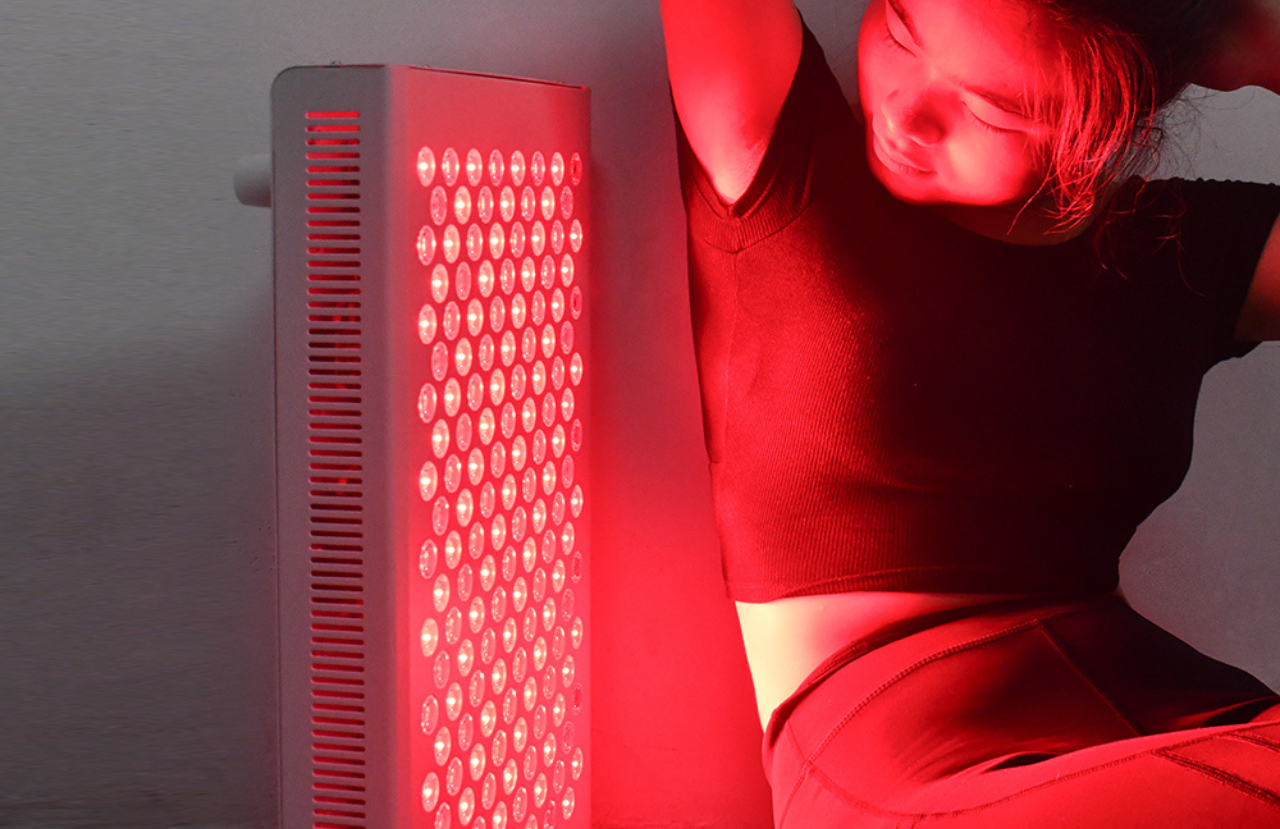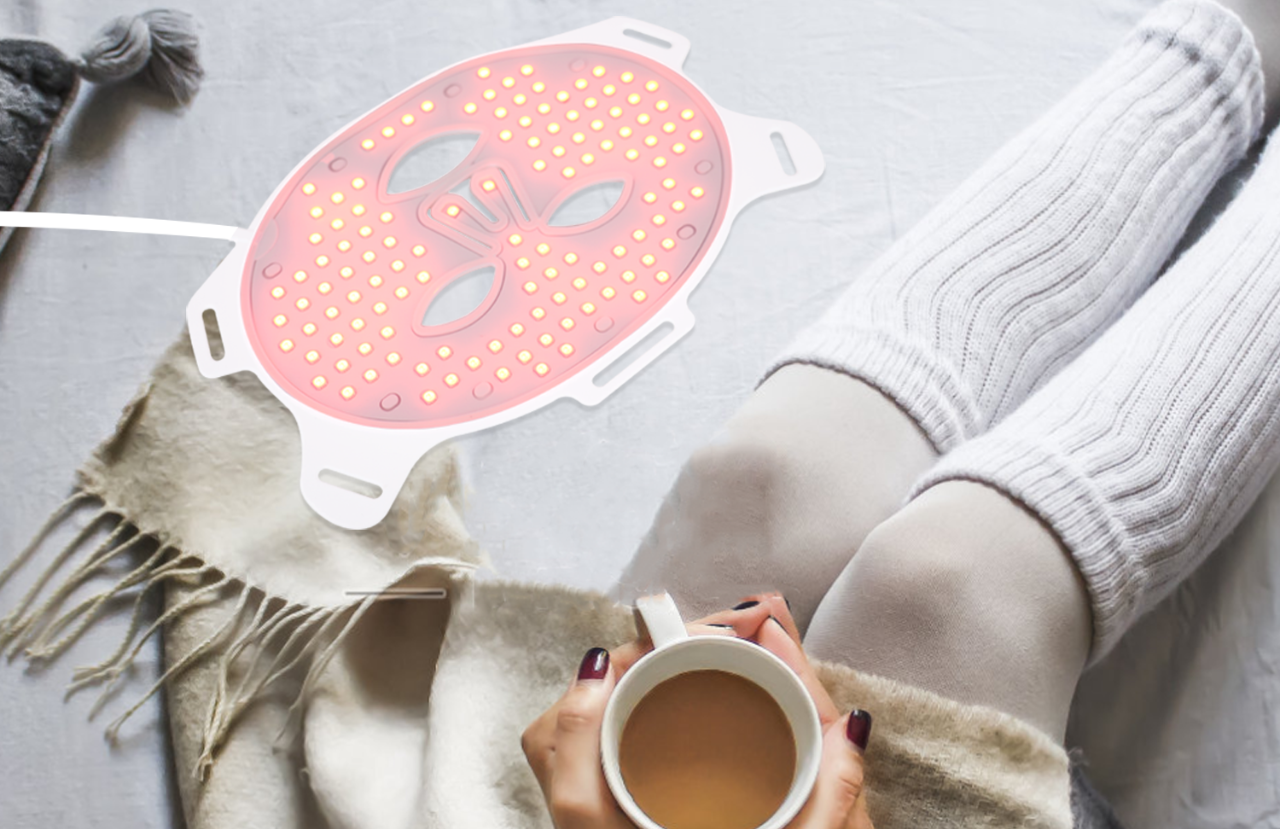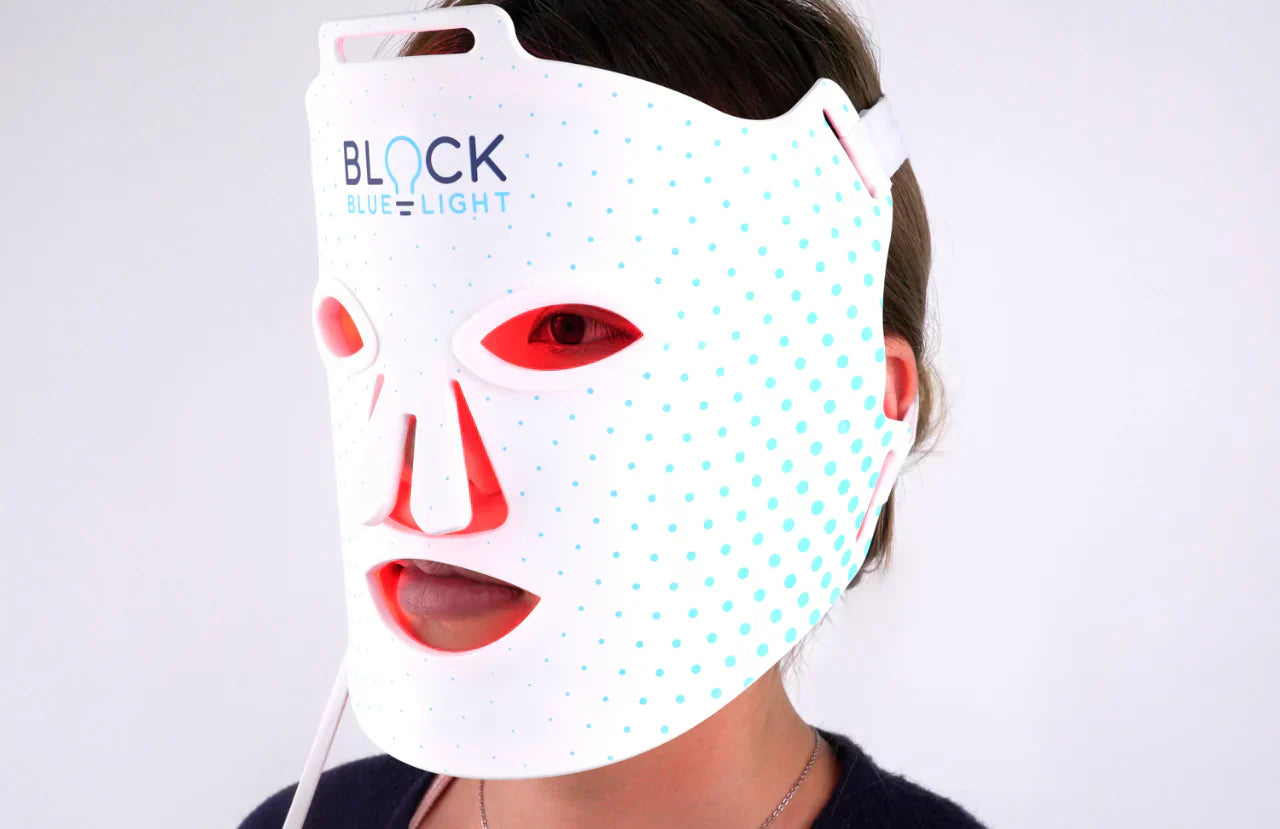Jump To Section
- Blue Light and the Light Spectrum
- Sources of Blue Light
- Blue Light Exposure Confuses the Brain
- Health Impacts of Excess Screen Time and LED Light Exposure
- Simple Hacks to Reduce Blue Light Exposure
Less than 150 years ago, humans were exposed to no artificial light. Moonlight, dim candlelight and the orange light of fire was all that illuminated the night. The rising and setting of the sun were clear indicators to our brain when the day's activity began and ended.
When the electric light bulb was invented, it opened up a whole new world. Artificial light allowed education, productivity and industry to grow rapidly. But could our pursuit of the endless day have a dark side?
The truth is our ever-increasing exposure to light from screens, bright office lighting, home lighting and street lights could be the most overlooked health risk of our modern lives. It’s having a devastating impact on our health, and we don’t realize it.
In this article, we'll explore the risks of chronic artificial light exposure and what you can do about it.
Blue Light and the Light Spectrum

Before we get into artificial light, you need to understand a bit about the light spectrum.
Light rays consist of alternating electric and magnetic waves that are measured in nanometres (nm). Light brightness – the intensity of light – is measured in lux. For example, moonlight is about 0.1 lux and the light of a living room at night is about 200 lux.
Most of the light in the universe is actually invisible to our eyes. However, the small spectrum of visible light consists of electromagnetic waves of various colours, including red, orange, yellow, green, blue and violet. The visible light spectrum appears white to us and ranges from 390 – 750nm.
Electromagnetic light waves on either side of the visible light spectrum are called infrared and ultraviolet waves.
On the visible light spectrum, the red-orange side of the spectrum are long-wavelength rays which have less energy. The light on the blue-violet end are short-wavelength rays which are high-energy.
Blue light waves − also known as high-energy visible (HEV) light − range in length from 380 to 500nm. Interestingly, these short-wavelengths are the reason the sky is blue. The high-energy rays scatter easily when they meet air and water molecules in the atmosphere, making a clear sky appear blue.
Natural blue light exposure − from sunlight − is actually beneficial for our health. The problem occurs when we are chronically exposed to artificial sources of blue light. While natural blue light from the sun is balanced with all the other colours of the light spectrum, blue light from LED light bulbs and electronic devices is concentrated and stimulating.
Keep reading as we explore this fascinating topic.
Sources of Blue Light

Nowadays, fluorescent and LED light bulbs, TVs, smartphones, tablets, eReaders, computers and laptops are major sources of artificial blue light. In fact, as technology develops, our exposure to artificial blue light is increasing.
In developed and developing countries, most of the population own at least one blue light-emitting device, with many people owning multiple devices. Additionally, as people search for energy efficient and affordable light bulbs, powerful LED lights at work, in the home and in the street are pervasive.
Artificial blue light seems inescapable. When we get home from work, we turn on many lights in the house and proceed to watch TV until it's time to go to bed. Even when we turn off the lights, LED alarm clocks, charging lights, and lights from the street send signals to our brain all night.
Blue Light Exposure Confuses the Brain

Exposure to blue light after sunset confuses the brain and messes with our body clock. This is because bright light controls our sleep-wake cycle – the circadian rhythm – and lets our brain know when to sleep and wake up.
We have light receptors – known as photoreceptors – in the retina of our eyes that closely monitor changes in light. Interestingly, the eyes are not the only way we sense light. The skin also has light receptors, which is how we are able to produce Vitamin D from sunlight exposure.
In the evening, we sense the fading light and it starts off a chain of events. The photoreceptors send a message to the suprachiasmatic nucleus (SCN) in a part of the brain called the hypothalamus. The SCN then tells the pineal gland in the brain to produce a hormone called melatonin, which prepares us for sleep. Melatonin levels stay high throughout the night, and in the morning the levels are suppressed when the same photoreceptors sense an increase in natural light. This signals our body to wake up.
Unfortunately, our constant exposure to blue light at night from screens, indoor lighting, and street lights sends signals to the brain that it’s still day time. This suppresses melatonin production and disrupts the normal circadian rhythm which leads to poor sleep and other health issues (1).
In 2012, The American Medical Association acknowledged that artificial night time light disrupts human circadian rhythms which have a direct impact on health (2).
Health Impacts of Excess Screen Time and LED Light Exposure
Our addiction to screens and the use of LED lights has skyrocketed in the last two decades. In terms of evolution, we have simply not had enough time to adapt, and it’s taking its toll.
Let's take a look at what the research says about what chronic overexposure to screens and artificial light could be doing to our wellbeing.
Sleep and Circadian Rhythm Disruption

You're probably familiar with the impact that drinking coffee at night has on your sleep. Well, blue light exposure actually delays the human circadian rhythm more than drinking a double espresso!
Exposure to screens at night strongly suppresses melatonin production and impacts our ability to fall asleep, stay asleep and feel alert in the morning.
Shockingly, blue light exposure at night may actually disrupt the non-rapid eye movement (NREM) stage of sleep. A study where people were exposed to 2 hours of different levels of blue-enriched light found that even relatively low room light in the evening resulted in less slow-wave brain activity during the first cycle of NREM sleep (3).
A study where subjects were exposed to computer screens from 9 pm to 11 pm found that sleep time, sleep quality and melatonin production was significantly decreased. Interestingly, the light exposure also prevented the natural drop in body temperature that should happen during the night. This further emphasizes that blue light exposure disrupts the body’s circadian rhythm and the related natural behaviours (4).
It's not just screens that are the problem. A 2011 study investigated melatonin levels in those exposed to bright room light versus dim light. It found that bright room lighting significantly suppressed melatonin levels and shortened melatonin production by 90 minutes (5).
The effects of sleep and circadian rhythm disruption could be far-reaching, as we know lack of sleep and poor sleep quality has been linked to diabetes, heart disease, cancer and more (6).
Blood Pressure
Our blood pressure is controlled by the autonomic nervous system, and it changes during the day, according to our natural circadian rhythm. It's naturally higher during the day, and when we fall into a deep sleep at night, our blood pressure drops. However, exposure to artificial blue light at night disrupts the circadian rhythm and has an impact on blood pressure control.
A study on older adults found that those exposed to brighter bedroom light at night had significantly higher night time blood pressure, irrespective of their melatonin levels (7).
Eye Damage

How many hours do you spend in front of a screen each day? It's believed that the majority of us spend at least 6 hours a day using a digital device. Unfortunately, but not unsurprisingly, spending a prolonged period of time working on a computer or staring at a TV or phone screen causes eye-strain.
We know that short-wave, high-energy blue light scatters easily. So, when we stare at screens that emit a lot of blue light we are essentially taking in unfocused light waves. This puts our eyes under a huge amount of stress as they repeatedly attempt to focus. It often leads to sore and tired eyes, headaches, fatigue, blurry vision and dry eyes.
Phew, it's tiring just thinking about it!
The risks of UV light waves from the sun on our skin and eyes are well-known, but blue light is actually more harmful to our eyes. We have no defence against blue light as it penetrates into the eye where it may damage the retina - a thin layer of tissue at the back of the eyeball (8).
We normally hold screens close to our face, so it's a double whammy for our eyes. This is especially worrying when it comes to children as their young eyes are not yet fully developed and are more sensitive to the effects of blue light.
Even sleeping in a room with relatively dim lighting has been found to cause eye tiredness, soreness and difficulty focusing (9). This is alarming, especially because so many people fall asleep in front of the TV, and children often sleep with a night light.
As if that isn't enough, the risk to our eyes goes deeper than this.
Research has identified blue light exposure as a risk for macular degeneration. Macular degeneration is one of the leading causes of blindness and occurs when the macular — photoreceptors in a part of the eye — is progressively destroyed. Researchers from the University of Toledo found that blue light reacts with a compound called retinal in the eye. This retinal becomes toxic and destroys the photoreceptor cells, which are unable to regenerate (10).
The research in this area seems quite clear. Prolonged screen time and blue light exposure are a major risk factor for eye damage and vision loss.
Cancer
It's looking more and more likely that our chronic exposure to blue light from LED screens and light bulbs could be linked to the skyrocketing cases of cancer. A 2017 review paper found strong links between long-term night shift workers and increased risk of breast cancer (11).
Now, a recent study has found that people living in Spanish cities with higher levels of nocturnal blue light have 1.5-2 times greater risk of getting breast or prostate cancer (12). In another study on the female population of Israel, a significant positive association was seen between breast cancer rates and areas of high light intensity at night (13).
This might be due to the ability of blue light to lower melatonin levels. Melatonin is known to have anticancer properties and lower melatonin levels are associated with an increased risk of cancer (14).
Insulin resistance and Diabetes

Insulin resistance is a chronic condition that occurs when cells become resistant to the blood-sugar-regulating hormone insulin. It leads to unstable blood sugar levels, weight gain, hormone imbalances and is a precursor to type-2 diabetes. Growing evidence is now suggesting blue light exposure could be throwing us into this pre-diabetic state.
A small study exposed participants to three hours of bright light, either half an hour after waking in the morning, or in the evening. All participants were given the same meal during the experiment. The results found that both groups had higher levels of insulin after the meal. However, those exposed to the light in the evening also had higher peak glucose levels, suggesting signs of insulin resistance (15).
Another study found that when healthy adults were exposed to roughly 100 lux of artificial light while they slept, insulin levels and indicators of insulin resistance increased after just one night (16).
This suggests that artificial blue light exposure at night is a risk factor for altered glucose metabolism, insulin resistance and eventually diabetes.
Weight Gain and Obesity

We've seen how artificial blue light can affect blood sugar and insulin levels, so it's no surprise that it could also be influencing the numbers on the scale.
Links between artificial light exposure, changes in feeding habits and weight gain have been confirmed in animal studies (17). Now, research has found a positive correlation between higher night time light exposure, decreased morning light exposure and weight gain and obesity (18, 19). Even more worryingly, a 2016 study on preschool-aged children found that higher levels of artificial light exposure accurately predicted an increased Body Mass Index a year later (20).
A 2014 study may offer an explanation for this. In the study, people who were exposed to bright blue light over a three hour period had increased hunger and were also found to have poorer glucose metabolism than those who were exposed to dim light (21).
The bottom line is that blue light exposure at night disrupts the body's natural cycles, including those of glucose metabolism, hunger and fullness. There is no doubt that this can lead to higher calorie consumption and weight gain.
Mood disorders
Mood disorders like depression and anxiety are on the rise. It’s possible this is linked to the effect that artificial light has on sleep quantity and quality. Most of us feel emotionally unstable if we haven’t slept well.
Animal studies have shown that blue light at night resulted in changes to the brain and depressive symptoms. However, when exposed to red light or total darkness those same changes were not seen (22).
Studies on humans are starting to reveal similar results. A review in Translational Psychiatry suggests that abnormal levels of light exposure at night affects the brain and alters our ability to regulate emotion and mood (23).
A study of more than 500 elderly people found that exposure to light at night was associated with more depressive symptoms (24). Additionally, studies on night shift workers suggest that those who engage in long-term shift work are more likely to suffer from major depression (25).
Emerging research also shows that children and teenagers who spend several hours each day interacting with screens are more likely to be depressed, anxious and emotionally unstable than those who have limited screen time (26).
Cortisol
Do you feel wired after too much screen time? Are you too anxious to fall asleep at night after watching TV?
Our stress hormone cortisol works in the opposite way to the sleep hormone melatonin. Levels of cortisol are supposed to rise in the morning as melatonin levels drop, and this encourages alertness. In the evening, as we become more relaxed and prepare for sleep, cortisol levels should drop as melatonin rises.
Research has shown that exposure to artificial light at night significantly increases night time cortisol levels (27). This increase in stress hormone may be a result of the circadian rhythm disruption, and night time light exposure could impact our ability to properly manage stress levels.
Simple Hacks to Reduce Blue Light Exposure
The results of the studies on the potential health impacts of screen time and LED lighting are pretty overwhelming. However, it's important to note that not ALL blue light exposure is bad for our health. It’s essential to get natural blue light from the sun to regulate our circadian rhythm and boost health and wellbeing.
What IS apparent is that artificial blue light exposure from screens and other sources needs to be avoided as much as possible during the day and eliminated after sunset.
Luckily, there are several blue light blocking “hacks” that you can use to improve your sleep and reduce the health risks associated with these light waves. We've compiled 5 tips to help you reduce your blue light exposure.
1.Use Blue Light Blocking Glasses

An easy and affordable way to block blue light from screens and indoor lighting is to wear blue light glasses. Depending on your needs, both orange-tinted and red-tinted glasses are available to block out blue light and give you the best protection. There are also glasses that will easily fit over your existing prescription frames.
If you spend a lot of time in front of screens during the day, clear computer glasses have specialized lenses to filter out blue light to reduce eye strain, regulate the circadian rhythm and reduce other health risks associated with artificial light exposure.
Research has confirmed the effectiveness of blue light blocking glasses. One study found that amber-tinted blue light blocking glasses worn for 3 hours before bed led to significant improvements in sleep quality (28). Another study among people with bipolar disorder found that those who wore tinted blue light blocking glasses overnight for a week had significant improvements in sleep (29).
2. Install Software to Block Blue Light
Software that changes the colour of the screen based on the time of day is now freely available for smartphones, tablets, laptops and computers. As the sun sets the colour of the screen will begin to emit an orange-red hue and less blue light.
Iris is an excellent option for your devices. Additionally, many smartphones and tablets have a built-in option to filter blue light from the device.
There's really no excuse not to use this software. However, this is only for extra-protection, you should still wear blue light blocking glasses.
3. Change Your Light Bulbs
As we mentioned earlier, our skin contains light receptors (30). So, while blue light blocking glasses and screen filters are a great help, we're still affected by the main source of lighting in our homes.
LED light bulbs may be affordable and environmentally friendly, but they are not doing your health any favors. It's vital to replace your conventional LED light bulbs with specially designed orange and red light bulbs that are low in blue light.
Be careful as any orange or red bulbs from he hardware store or supermarket wont do the trick; many of these "party" type colored bulbs simply have just painted the bulb to make it colorful and lots of harmful blue light is still being emitted from them. Only our bulbs are guaranteed to be void of any blue light.
Focus on replacing the light bulbs in areas that you spend the most time in, like the living room, office, bedrooms, kitchen and dining room.
It's important that you don't switch on any main lights in the middle of the night. Install a red light bulb next to your bed to use for light when you wake up during the night. If your children need light in their room at night, a red night light is the only option.
Get each member of the family a red light torch, so they can navigate their way to the bathroom in the night without turning on bright lights that will disrupt melatonin production.
For those who work evenings or late into the night, the office lighting also needs to change. If you are able to, try speaking to your colleagues or boss about replacing the office lighting in favour of orange light bulbs low in blue light. This will benefit the health of all employees and improve productivity.

4. Keep Your Room Dark
For good quality sleep, it’s essential that you sleep in total darkness.
Even if you eliminate and minimize as many blue light sources in your home as you can, light pollution from outside will still cause problems. Studies have shown that people living in areas with high levels of environmental lighting have more insomnia and daytime fatigue (31).
We can still perceive light with our eyes closed and even a small amount is enough to disrupt circadian rhythm and affect sleep quality. So, focus on making your room as dark as possible at night. If you can see your hand in front of your face, it's not dark enough.
Follow these steps to ensure your room is dark enough:
- Invest in high-quality block out curtains.
- Banish the TV, smartphone, laptop, charging stations and LED alarm clock from the bedroom.
- Use an eye mask while you sleep.
5. Manage Screen Time
We can all agree that our use of screens has become excessive. Even if we block out the majority of the blue light coming from these devices, too much screen time is stimulating and may stop us from falling into a restful sleep.
Limit your screen time when you're at home and try to turn off all devices at least an hour before bed to wind down. Read a (real) book, listen to music, play a board game or just talk to your loved ones.
If you work long hours in front of a computer, take breaks as often as you can. Close your eyes for ten seconds every hour and when you can remember focus on an object in the distance to reduce eye strain. It's also important to go outside and expose yourself to natural sources of light if you're cooped up in front of a computer all day.
Final Thoughts
As you can see, findings from current research on the negative health impacts of being chronically exposed to blue light from screen time and LED lighting is alarming.
Luckily, you don't need to resign yourself to living in a tent in the forest and throwing away your beloved devices. The simple tools and lifestyle changes outlined in this article will go a long way to reducing you and your family's exposure to artificial blue light.
Resources
- Stevens and Zhu. (2015). Electric light, particularly at night, disrupts human circadian rhythmicity: is that a problem? Available at: https://www.ncbi.nlm.nih.gov/pubmed/25780233
- Stevens et al. (2013). Adverse health effects of night time lighting: comments on American Medical Association policy statement. Available at: https://www.ncbi.nlm.nih.gov/pubmed/23953362
- Chellappa et al. (2013). Acute exposure to evening blue‐enriched light impacts on human sleep. Available at: https://onlinelibrary.wiley.com/doi/full/10.1111/jsr.12050
- Blue light emitted by screens damages our sleep, study suggests. (2017). Available at: https://www.sciencedaily.com/releases/2017/08/170822103434.htm
- Gooley et al. (2011). Exposure to room light before bedtime suppresses melatonin onset and shortens melatonin duration in humans. Available at: https://www.ncbi.nlm.nih.gov/m/pubmed/21193540
- Medic et al. (2017). Short and long-term health consequences of sleep disruption. Available at: https://www.ncbi.nlm.nih.gov/pmc/articles/PMC5449130/
- Obayashi et al. (2014). Association between light exposure at night and night time blood pressure in the elderly independent of nocturnal urinary melatonin excretion. Available at: https://www.ncbi.nlm.nih.gov/pubmed/24673296
- Zhao et al. (2018). Research progress about the effect and prevention of blue light on eyes. Available at: https://www.ncbi.nlm.nih.gov/pmc/articles/PMC6288536/
- Suh et al. (2018). Effect of ambient light exposure on ocular fatigue during sleep. Available at: https://www.ncbi.nlm.nih.gov/pmc/articles/PMC6137029/
- UT chemists discover how blue light speeds blindness. (2018). Available at: http://utnews.utoledo.edu/index.php/08_08_2018/ut-chemists-discover-how-blue-light-speeds-blindness
- Hansen. (2017). Night shift work and risk of breast cancer. Available at: https://www.ncbi.nlm.nih.gov/m/pubmed/28770538
- Study links night exposure to blue light with breast and prostate cancer. (2018). Available at: https://www.sciencedaily.com/releases/2018/04/180425120242.htm
- Kloog et al. (2008). Light at night co-distributes with incident breast but not lung cancer in the female population of Israel. Available at: https://www.ncbi.nlm.nih.gov/pubmed/18293150?dopt=Abstract&holding=npg
- Schernhammer and Schulmeister. (2004). Melatonin and cancer risk: does light at night compromise physiologic cancer protection by lowering serum melatonin levels? Available at: https://www.ncbi.nlm.nih.gov/pmc/articles/PMC2409637
- Cheung et al (2016). Morning and evening blue-enriched light exposure alters metabolic function in normal weight adults. Available at: https://www.ncbi.nlm.nih.gov/pmc/articles/PMC4871543/
- Light exposure during sleep may increase insulin resistance. (2018). Available at: https://www.sciencedaily.com/releases/2018/06/180604172736.htm
- Fonken et al. (2013). Dim light at night disrupts molecular circadian rhythms and increases body weight. Available at: https://www.ncbi.nlm.nih.gov/m/pubmed/23929553/
- Obayashi et al. (2016). Ambient light exposure and changes in obesity parameters: a longitudinal study of the HEIJO-KYO cohort. Available at: https://www.ncbi.nlm.nih.gov/m/pubmed/27383113/
- McFadden et al. (2014). The relationship between obesity and exposure to light at night: cross-sectional analyses of over 100,000 women in the breakthrough generations study. Available at: https://www.ncbi.nlm.nih.gov/pubmed/24875371
- Pattinson et al. (2016). Environmental light exposure Is associated with increased body mass in children. Available at: https://journals.plos.org/plosone/article?id=10.1371/journal.pone.0143578
- Evening blue light exposure linked to increased hunger. (2014). Available at: https://www.sciencedaily.com/releases/2014/06/140602115916.htm
- What colour is your night light? It may affect your mood. (2013). Available at: https://www.sciencedaily.com/releases/2013/08/130806203150.htm
- Bedrosian and Nelson. (2017). Timing of light exposure affects mood and brain circuits. Available at: https://www.nature.com/articles/tp2016262
- Obayashi et al. (2013). Exposure to light at night and risk of depression in the elderly. Available at: https://www.ncbi.nlm.nih.gov/pubmed/23856285
- Lee et al. (2017). Night shift work and risk of depression: meta-analysis of observational studies. Available at: https://www.ncbi.nlm.nih.gov/pmc/articles/PMC5461311/
- Twenge and Campbell. (2018). Associations between screen time and lower psychological well-being among children and adolescents: Evidence from a population-based study. Available at: https://www.sciencedirect.com/science/article/pii/S2211335518301827
- Figueiro and Rea. (2010). The effects of red and blue lights on circadian variations in cortisol, alpha amylase, and melatonin. Available at: https://www.ncbi.nlm.nih.gov/pmc/articles/PMC2905913/
- Burkhart and Phelps. (2009). Amber lenses to block blue light and improve sleep: a randomized trial. Available at: https://www.ncbi.nlm.nih.gov/pubmed/20030543
- Henriksen et al. (2016). Blue-blocking glasses as additive treatment for mania: a randomized placebo-controlled trial. Available at: https://www.ncbi.nlm.nih.gov/pmc/articles/PMC5089565/
- Iyengar. (2013). The melanocyte photosensory system in the human skin. Available at: https://www.ncbi.nlm.nih.gov/pubmed/23807911
- Ohayon and Milesi. (2016). Artificial outdoor night time lights associate with altered sleep behavior in the American General Population. Available at: https://academic.oup.com/sleep/article/39/6/1311/2454030
